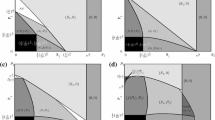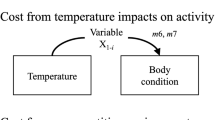Summary
-
1.
The predictions of game theory concerning the use of resource assessment strategies by animals in conflict situations were tested through study of the agonistic behavior of the funnel-web spider, Ageleropsis aperta, in disputes over web sites and associated territories. Specifically, contest cost was considered relative to resource value (i.e., the quality and availability of territories).
-
2.
The contest methodology was similar to that described in Riechert (1978a) with weight controlled to eliminate size bias. In addition, relative contest costs were converted to joules using resting metabolism under field conditions as a reference. Estimates of territory quality and availability were made through the application of a model of spider reproductive success to the results of discriminant analyses of site characteristics.
-
3.
The immediate and ultimate benefits of ownership of specific territories accounts for a significant amount of the within-population variability in dispute cost-the greater the benefit, the greater the total cost of the dispute. The territory owner is shown to determine the level of escalation reached in these contests, while the intruder merely adjusts its behavior to that of its opponent.
-
4.
Contest behavior is also shown to vary according to the relative availability of territories: more energy is expended in maintaining and winning territories in a habitat near saturation (desert grassland) than where territories are in ready supply (desert riparian).
-
5.
A greater range of benefits was available to spiders occupying specific sites in the desert grassland study area than to the riparian population. This was emphasized by the greater variability in contest cost, richness, and in the total number of acts exhibited in the sequences involving desert grassland spiders. Prey availability and ultimately reproductive success were found to be correlated with web-site quality in the desert grassland habitat, whereas differential utilization of specific habitat types by the riparian spiders corresponded not to reproductive potential but to the ease of web placement.
-
6.
The correspondance existing between within-population contest cost and site quality reflects active resource assessment on the part of the territory owner, while population differences observed in the level of escalation achieved in disputes over territories is attributed to selection pressure for evolved differences in level of aggression. These findings are discussed in terms of optimization and relative to the predictions of game theory.
Similar content being viewed by others
References
Alkmann, S.A.: Baboons, space, time and energy. Am Zool. 14, 221–248 (1974)
Catana, A.J.: The wandering quadrant: A new ecological method utilizing interspace measurements. Bull. Ecol. Soc. 36, 88 (1955)
Connover, W.J.: Practical nonparametric statistics. New York: John Wiley and Sons 1971
Curtis, J.T.: The vegetation of Wisconsin. Madison: University of Wisconsin 1959
Davies, N.B.: Territorial defence in the speckled wood butterfly (Pararge aegeria) (Lep., Satyridae): The resident always wins. Anim. Behav. 26, 138–147 (1978)
Gertsch, W.J., Riechert, S.E.: The spatial and temporal partitioning of a desert spider community, with descriptions of new species. Am. Mus. Novit. 2604, 1–25 (1976)
Hazlett, B.A., Estabrook, G.F.: Examination of agonistic behavior by character analysis: II. Hermit crabs. Behavior 49, 88–110 (1974a)
Hazlett, B.A., Estabrook, G.F.: Examination of agonistic behavior by character analysis. I. The spider crab Microphrys bicornutus. Behavior 48, 131–144 (1974b)
Hines, W.G.S.: Competition with an evolutionary stable strategy. J. Theor. Biol. 67, 141–153 (1977)
Huntingford, F.A.: The relationship between inter and intraspecific aggression. Anim. Behav. 24, 485–497 (1976)
Maynard Smith, J.: On evolution. Edinburgh: Edinburgh University 1972
Maynard Smith, J.: The theory of games and the evolution of animal conflict. J. Theor. Biol. 47, 209–221 (1974)
Maynard Smith, J.: Evolution and the theory of games. Am. Sci. 64, 41–45 (1976)
Maynard Smith, J., Parker, G.A.: The logic of asymmetric contests. Anim. Behav. 24, 159–175 (1976)
Maynard Smith, J., Price, G.R.: The logic of animal conflict. Nature 246, 15–18 (1973)
Neuman, von, J., Morgenstern, O.: Theory of games and economic behavior. Princeton: Princeton University 1944
Parker, G.A.: Assessment strategy and the evolution of fighting behavior. J. Theor. Biol. 47, 223–243 (1974)
Parker, G.A.: Selfish genes, evolutionary games, and the adaptiveness of behavior. Nature 274, 849–855 (1978)
Parker, G.A., Stuart, R.A.: Animal behavior as a strategy optimizer: Evolution of resource assessment strategies and optimal emigration threshold. Am. Nat. 110, 1055–1076 (1976)
Pimental, R.A., Frey, D.F.: Multivariate analysis of variance and discriminant analyses. In. Quantitative ethology. Colgan, P.W. (ed.) New York: Wiley 1978
Rand, W.M., Rand, A.S.: Agonistic behavior in nesting iguanas: A stochastic analysis of dispute settlement dominated by the minimization of energy cost. Z. Tierpsychol 40, 279–299 (1976)
Riechert, S.E.: Web-site selection in a desert Spider, Agelenopsis aperta (Gertsch). Oikos 27, 311–315 (1976)
Riechert, S.E.: Games spiders play: Behavioral variability in territorial disputes. Behav. Ecol. Sociobiol. 3, 135–162 (1978a)
Riechert, S.E.: Energy-based territoriality in population of the desert spider Agelenopsis aperta (Gertsch). Symp. J. Zool. Soc. London 42, 211–222 (1978b)
Riechert, S.E., Tracy, C.R.: Thermal balance and prey availability: Bases for a model relating web-site characteristics to spider reproductive success. Ecology 56, 265–284 (1975)
Silby, R., McFarland, D.: On the fitness of behavior sequences. Am. Nat. 110, 601–617 (1976)
Sokal, R.R., Rolf, F.J.: Biometry. San Francisco: Freeman 1969
Stephenson, G.R., Smith, D.P., Roberts, T.W.: The SSR system. An open format event recording system with computerized transcriptions. Behav. Res. Math. Instrum. 7, 497–515 (1975)
Welch, H., Stainsby, W.: Oxygen debt in contracting dog skeletal muscle in situ. Respir. Physiol 3, 229–242 (1967)
Author information
Authors and Affiliations
Rights and permissions
About this article
Cite this article
Richert, S.E. Games spiders play. Behav Ecol Sociobiol 6, 121–128 (1979). https://doi.org/10.1007/BF00292558
Received:
Accepted:
Issue Date:
DOI: https://doi.org/10.1007/BF00292558




